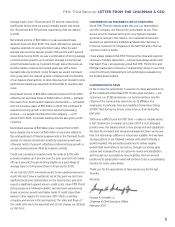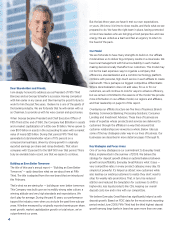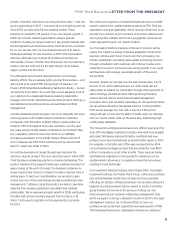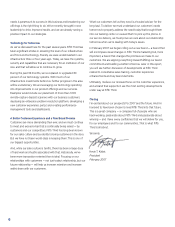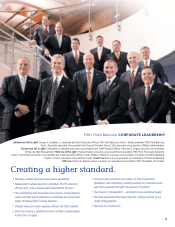Fifth Third Bank 2006 Annual Report Download - page 12
Download and view the complete annual report
Please find page 12 of the 2006 Fifth Third Bank annual report below. You can navigate through the pages in the report by either clicking on the pages listed below, or by using the keyword search tool below to find specific information within the annual report.
The affiliate model is at the core of Fifth Third and is what
differentiates us from other large financial institutions. We operate
each affiliate with local management. Each affiliate has an
experienced president and senior management team, resident in
each market, driving the business. And each affiliate has a board of
directors comprised of local business and community leaders. This
means that we have local decision-makers, able to view customer
relationships in holistic ways, making local decisions.
This model gives us a tremendous competitive advantage in our
responsiveness to customers; in attracting employees who want to
control the customer relationship locally; and in giving us 19 “mini-
incubators” for new ideas and best practices. Our entrepreneurial
and sales cultures are at the heart of the affiliate model, and
contribute tremendously to Fifth Third’s success.
Maintaining competitive advantage.
Overlaying the affiliate structure are our lines of business. These are
essentially areas of product expertise — Branch Banking, Consumer
Lending, Commercial Banking, Processing Solutions and Investment
Advisors — whose products and services are delivered to customers
through the affiliates in a way that ensures customer relationships
are viewed as a whole.
As an example of the kind of success we can produce with this
model, we have 19 affiliates plus our Pittsburgh and St. Louis
de novo markets. For the year ended June 2006 (most recent FDIC
data), 20 of these 21 markets (including the de novo markets) grew
deposits. Excluding branches with over $1 billion in deposits, all
21 markets grew deposits and 17 of the 21 markets grew deposit
market share (18 of 21 excluding $1 billion branches).
Affiliate Leadership
Chicago Region Terry Zink 312 $17.3B 25%
Chicago Terry Zink
Central Indiana John Pelizzari
Southern Indiana John Daniel
Tennessee Dan Hogan
Western Michigan Region Michelle VanDyke 273 $15.2B 22%
Western Michigan Michelle VanDyke
Eastern Michigan Greg Kosch
Northern Michigan Mark Eckhoff
Tampa Bay Brian Keenan
Cincinnati Region Bob Sullivan 205 $12.6B 18%
Cincinnati Bob Sullivan
Louisville Phil McHugh
Central Kentucky Sam Barnes
Northern Kentucky Tim Rawe
Cleveland Region Todd Clossin 187 $10.9B 16%
Northeastern Ohio Todd Clossin
Northwestern Ohio Robert LaClair
South Florida Tom Quinn
Columbus Region Bob Eversole 173 $ 9.4B 14%
Central Ohio Bob Eversole
Western Ohio Ray Webb
Ohio Valley David Call
Central Florida John Bultema
Affiliate* President Banking Centers Deposits % of Deposits
*Bancorp deposits also include $4 billion in National and non-affiliate deposits.
Affiliate Model
10





